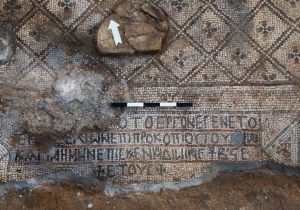The well-preserved coloured mosaic floor from a Georgian church or monastery was uncovered in the coastal city of Ashdod, South-East Israel. The mosaic is said to be 1500 years old.

The mosaic was discovered at an ancient settlement mound of Ashdod-Yam by archaeologists led by Alexander Fantalkin of Tel Aviv University’s Archeology and Ancient Near Eastern Civilizations Department, and Angelika Berlejung of Leipzig University. The ancient artwork includes a fourline Greek commemorative inscription dedicated to the structure’s builder, Bishop Procopius, as well as the year of its construction, based on the Georgian calendar. According to Leah Di Segni, of the Hebrew University of Jerusalem, who deciphered the inscription the text translates as follows: [By the grace of God (or Jesus)], this work was done from the foundation under Procopius, our most saintly and most holy bishop, in the month Dios of the 3rd indiction, year 292. The year mentioned in the inscription, being 539 AD, might be the earliest appearance of the use of the Georgian calendar in Israel.

According to the researchers, the ancient city of Ashdod-Yam, known in sources from the period as Azotus Paralios, was one of the most important cities on the coast of Israel in the Byzantine period. It covered a large area and housed public buildings, including churches and a street flanked by colonnades. It also is believed to have been home to the largest community of Jews of Georgian origin in the world. The researchers state that this is also the first time that a Georgian church or monastery has been discovered on the Israeli coast.

(after Anat Resyuk, Israel Antiquities Authority & The Jerusalem Post)